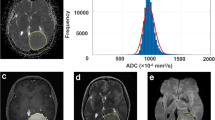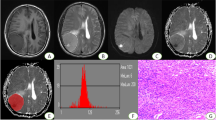Abstract
Objective
To investigate the predictive value of a model combining conventional MRI features and apparent diffusion coefficient (ADC) histogram parameters for meningioma recurrence.
Materials and Methods
Seventy-two meningioma patients confirmed by surgical and pathological findings in our hospital (January 2017–June 2020) were retrospectively and divided into the recurrence and non-recurrence group. MaZda software was used to delineate the region of interest at the largest tumor level and generate histogram parameters. Univariate and multivariate logistic regression analysis were used to construct the nomogram for predicting recurrence. The predictive efficacy and diagnostic of this model were assessed by calibration and decision curve analysis, and receiver operating characteristic curve, respectively.
Results
Maximum diameter, necrosis, enhancement uniformity, age, Simpson, tumor shape, and ADC first percentile (ADCp1) were significantly different between the two groups (p < 0.05), with the latter four being independent risk factors for recurrence. The model constructed combining the four factors had the best predictive efficacy, and the area under the curve, accuracy, sensitivity, specificity, positive predictive value, and negative predictive value were 0.965(0.892–0.994), 90.3%, 92.6%, 88.9%, 83.3%, and 95.2%, respectively. The calibration curve showed good agreement between the model-predicted and actual probabilities of recurrence. The decision curve analysis indicated good clinical availability of the model.
Conclusion
This model based on conventional MRI features and ADC histogram parameters can directly and reliably predict meningioma recurrence, providing a guiding basis for selecting treatment options and individualized treatment.






Similar content being viewed by others
Data availability
Not applicable.
References
Bohara M, Nakajo M, Kamimura K, Yoneyama T, Fukukura Y, Kiyao Y et al (2020) Histological grade of meningioma: prediction by intravoxel incoherent motion histogram parameters. Acad Radiol 27(3):342–353. https://doi.org/10.1016/j.acra.2019.04.012
Cao X, Hao S, Wu Z, Wang L, Jia G, Zhang L, Zhang J (2015) Treatment response and prognosis after recurrence of atypical meningiomas. World Neurosurg 84(4):1014–1019. https://doi.org/10.1016/j.wneu.2015.05.032
Chen XY, Chen JY, Huang YX, Xu JH, Sun WW, Chen Y et al (2021) Establishment and validation of an integrated model to predict postoperative recurrence in patients with atypical meningioma. Front Oncol 11:754937. https://doi.org/10.3389/fonc.2021.754937
Chen C, Ren CP, Zhao RC, Ding JW, Cheng JL (2019) Histogram analysis parameters ADC for distinguishing ventricular neoplasms of ependymoma, choroid plexus papilloma, and central neurocytoma. Med Sci Monit 25:5886–5891. https://doi.org/10.12659/msm.915398
Corniola MV, Lemée JM, Da Broi M, Joswig H, Schaller K, Helseth E, Meling TR (2019) Posterior fossa meningiomas: perioperative predictors of extent of resection, overall survival and progression-free survival. Acta Neurochir (Wien) 161(5):1003–1011. https://doi.org/10.1007/s00701-019-03862-z
Duan C, Zhou X, Wang J, Li N, Liu F, Gao S et al (2022) A radiomics nomogram for predicting the meningioma grade based on enhanced T1WI images. Br J Radiol. https://doi.org/10.1259/bjr.20220141
Gallagher MJ, Jenkinson MD, Brodbelt AR, Mills SJ, Chavredakis E (2016) WHO grade 1 meningioma recurrence: are location and simpson grade still relevant? Clin Neurol Neurosurg 141:117–121. https://doi.org/10.1016/j.clineuro.2016.01.006
Garzon-Muvdi T, Maxwell R, Luksik A, Kessler R, Weingart J, Olivi A et al (2020) Scalp invasion by atypical or anaplastic meningioma is a risk factor for development of systemic metastasis. World Neurosurg 142:e133–e139. https://doi.org/10.1016/j.wneu.2020.06.148
Gousias K, Schramm J, Simon M (2016) The Simpson grading revisited: aggressive surgery and its place in modern meningioma management. J Neurosurg 125(3):551–560. https://doi.org/10.3171/2015.9.Jns15754
Haddad AF, Young JS, Kanungo I, Sudhir S, Chen JS, Raleigh DR et al (2020) WHO Grade I meningioma recurrence: identifying high risk patients using histopathological features and the MIB-1 index. Front Oncol 10:1522. https://doi.org/10.3389/fonc.2020.01522
Hortobágyi T, Bencze J, Varkoly G, Kouhsari MC, Klekner Á (2016) Meningioma recurrence. Open Med (Wars) 11(1):168–173. https://doi.org/10.1515/med-2016-0032
Ko CC, Zhang Y, Chen JH, Chang KT, Chen TY, Lim SW et al (2021) Pre-operative MRI radiomics for the prediction of progression and recurrence in meningiomas. Front Neurol 12:636235. https://doi.org/10.3389/fneur.2021.636235
Kondo M, Uchiyama Y (2018) Apparent diffusion coefficient histogram analysis for prediction of prognosis in glioblastoma. J Neuroradiol 45(4):236–241. https://doi.org/10.1016/j.neurad.2017.11
Kurokawa R, Baba A, Kurokawa M, Capizzano A, Hassan O, Johnson T et al (2022) Pretreatment ADC histogram analysis as a prognostic imaging biomarker for patients with recurrent glioblastoma treated with bevacizumab: a systematic review and meta-analysis. AJNR Am J Neuroradiol 43(2):202–206. https://doi.org/10.3174/ajnr.A7406
Liu X, Huang X, Han T, Li S, Xue C, Deng J et al (2022) Discrimination between microcystic meningioma and atypical meningioma using whole-lesion apparent diffusion coefficient histogram analysis. Clin Radiol 77(11):864–869. https://doi.org/10.1016/j.crad.2022.07.004
Louis DN, Ohgaki H, Wiestler OD et al (2016) WHO classifification of tumours of the central nervous system. 4th ed. Lyon, France: International Agency for Research on Cancer
Mo G, Jiang Q, Bao Y, Deng T, Mo L, Huang Q (2023) A nomogram model for stratifying the risk of recurrence in patients with meningioma after surgery. World Neurosurg. 176:e644–e650. https://doi.org/10.1016/j.wneu.2023.05.113
Ogasawara C, Philbrick BD, Adamson DC (2021) Meningioma: a review of epidemiology, pathology, diagnosis, treatment, and future directions. Biomedicines. https://doi.org/10.3390/biomedicines9030319
Ostrom QT, Cioffi G, Waite K, Kruchko C, Barnholtz-Sloan JS (2021) CBTRUS statistical report: primary brain and other central nervous system tumors diagnosed in the United States in 2014–2018. Neuro Oncol 23(12 Suppl 2):iii1–iii105. https://doi.org/10.1093/neuonc/noab200
Ozturk M, Polat AV, Selcuk MB (2021) Whole-lesion ADC histogram analysis versus single-slice ADC measurement for the differentiation of benign and malignant soft tissue tumors. Eur J Radiol 143:109934. https://doi.org/10.1016/j.ejrad.2021.109934
Payabvash S, Tihan T, Cha S (2018) Volumetric voxelwise apparent diffusion coefficient histogram analysis for differentiation of the fourth ventricular tumors. Neuroradiol J 31(6):554–564. https://doi.org/10.1177/1971400918800803
Raman SG, Prakash P, Sumit J, Bikram SD, Prasanna K (2021) Clinical outcome and recurrence after meningioma surgery: an experience from a develo** country, Nepal. World Neurosurg 148:e138–e144. https://doi.org/10.1016/j.wneu.2020.12.079
Ren J, Yuan Y, Wu Y, Tao X (2018) Differentiation of orbital lymphoma and idiopathic orbital inflammatory pseudotumor: combined diagnostic value of conventional MRI and histogram analysis of ADC maps. BMC Med Imag 18(1):6. https://doi.org/10.1186/s12880-018-0246-8
Umanodan T, Fukukura Y, Kumagae Y, Shindo T, Nakajo M, Takumi K et al (2017) ADC histogram analysis for adrenal tumor histogram analysis of apparent diffusion coefficient in differentiating adrenal adenoma from pheochromocytoma. J Magn Reson Imag 45(4):1195–1203. https://doi.org/10.1002/jmri.25452
Xu XQ, Li Y, Hong XN, Wu FY, Shi HB (2017) Radiological indeterminate vestibular schwannoma and meningioma in cerebellopontine angle area: differentiating using whole-tumor histogram analysis of apparent diffusion coefficient. Int J Neurosci 127(2):183–190. https://doi.org/10.3109/00207454.2016.1164157
Xue C, Liu S, Deng J, Liu X, Li S, Zhang P, Zhou J (2022) Apparent diffusion coefficient histogram analysis for the preoperative evaluation of Ki-67 expression in pituitary macroadenoma. Clin Neuroradiol 32(1):269–276. https://doi.org/10.1007/s00062-021-01134-x
Youngblood MW, Miyagishima DF, ** L, Gupte T, Li C, Duran D et al (2021) Associations of meningioma molecular subgroup and tumor recurrence. Neuro Oncol 23(5):783–794. https://doi.org/10.1093/neuonc/noaa226
Zhang J, Yao K, Liu P, Liu Z, Han T, Zhao Z et al (2020) A radiomics model for preoperative prediction of brain invasion in meningioma non-invasively based on MRI: a multicentre study. EBioMedicine 58:102933. https://doi.org/10.1016/j.ebiom.2020.102933
Zhang GS, Zhang YY, He F, Ou ML, Wang LK, Liao L et al (2021) Primary intracranial papillary meningioma: analysis of factors of prognosis and systematic review. J Clin Neurosci 91:118–124. https://doi.org/10.1016/j.jocn.2021.06.025
Zhang J, Zhang G, Cao Y, Ren J, Zhao Z, Han T et al (2022) A magnetic resonance imaging-based radiomic model for the noninvasive preoperative differentiation between transitional and atypical meningiomas. Front Oncol 21(12):811767. https://doi.org/10.3389/fonc.2022.811767
Funding
This study was supported by grants of National Science Foundation of China (No. 82071872), Lanzhou University Second Hospital “Cuiying Technology Innovation Plan” Applied Basic Research Project (No. CY2018-QN09), and Science and Technology Program of Gansu Province (No. 21YF5FA123), China International Medical Foundation (No. Z-2014-07-2101), National Science Foundation of Gansu Province (No. 21JR11RA105), and Natural Science Foundation of China (No. 82371914).
Author information
Authors and Affiliations
Contributions
TH (Theoretical design, data processing, article writing, major revisions, approved of submission on behalf of all authors) XL (Data processing, statistical analysis) MJ (Formal analysis, Resources, Data curation) YZ (Data processing) LD (Data processing) BZ (Statistical analysis) JZ, MD, PhD. (Theoretical guidance, article revision suggestions, supportive contribution).
Corresponding author
Ethics declarations
Competing interests
The authors declare no competing interests.
Ethics approval
This study was approved by the Medical Ethics Committee of the Second Hospital of Lanzhou University (approval number: 2020A-109) and informed consent was waived.
Additional information
Publisher's Note
Springer Nature remains neutral with regard to jurisdictional claims in published maps and institutional affiliations.
Rights and permissions
Springer Nature or its licensor (e.g. a society or other partner) holds exclusive rights to this article under a publishing agreement with the author(s) or other rightsholder(s); author self-archiving of the accepted manuscript version of this article is solely governed by the terms of such publishing agreement and applicable law.
About this article
Cite this article
Han, T., Liu, X., **g, M. et al. The value of an apparent diffusion coefficient histogram model in predicting meningioma recurrence. J Cancer Res Clin Oncol 149, 17427–17436 (2023). https://doi.org/10.1007/s00432-023-05463-x
Received:
Accepted:
Published:
Issue Date:
DOI: https://doi.org/10.1007/s00432-023-05463-x




